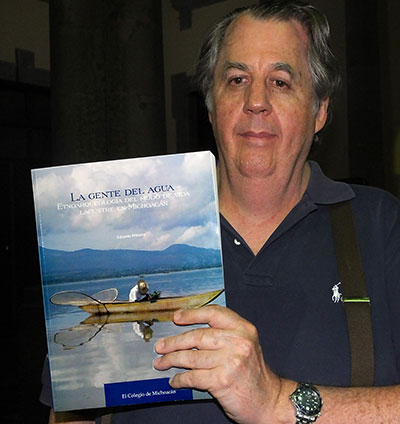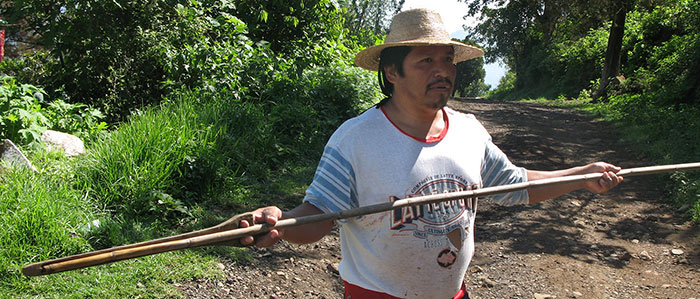|
By John Pint
 La Gente del Agua is a 416-page book, all in Spanish, representing
twenty years of study by Doctor Eduardo Williams of the “fishers”—as he
calls them, avoiding gender prejudice—who live on the shores of lakes
Cuitzeo and Pátzcuaro in Michoacán. Page through this book and you will
find hundreds of beautiful photos which suggest that this is not only
an impressive work of scholarly importance, but also a labor of love.
Fortunately for English speakers, Williams has produced a 165-page,
well-illustrated, abridged version of this book in excellent English,
which can be downloaded here from Academia.edu.
La Gente del Agua is a 416-page book, all in Spanish, representing
twenty years of study by Doctor Eduardo Williams of the “fishers”—as he
calls them, avoiding gender prejudice—who live on the shores of lakes
Cuitzeo and Pátzcuaro in Michoacán. Page through this book and you will
find hundreds of beautiful photos which suggest that this is not only
an impressive work of scholarly importance, but also a labor of love.
Fortunately for English speakers, Williams has produced a 165-page,
well-illustrated, abridged version of this book in excellent English,
which can be downloaded here from Academia.edu.
Williams’ study of modern-day people using the resources of these lakes
says much about the way the Tarascans lived in the same area before the
arrival of the Spaniards. This work is a response to a cry for help
made in 2001 by archaeologist Jeffrey Parsons in “The Last Saltmakers
of Nexquipayac, Mexico: An Archaeological Ethnography.”
Parsons says that
There are many traditional activities hovering on the edge of
extinction that deserve... recording in Mexico and throughout the
world. Few scholars appear to be much interested in studying the
material and organizational aspects of these vanishing lifeways, and
archaeologists may be virtually alone in making such efforts as do
exist. In one sense this… is a plea to others to undertake comparable
studies elsewhere while there is still a little time left to do so…
(Parsons 2001:xiv).
As Eduardo Williams points out, studies of this sort need to be carried
out by archaeologists, not by researchers in other social sciences,
because a certain sensitivity and attention to detail are required for
a highly specialized interpretation of the data, focused on how our
ancestors carried on similar activities. However, I think few
archaeologists have the patience to give so much of their time to a
contemporary society. For those who are willing to take up the
challenge, La Gente del Agua will be an admirable guide.
In the course of this research, the author of the book was surprised to
discover that one of the main tools used for manufacturing sleeping
mats (petates) and baskets from lake reeds, was identical to one
employed by the most ancient of our ancestors, possibly the oldest
known tool on earth. This was a flat, rounded rock that most of us
would pay no attention to whatsoever, unless neon signs were pointing
to it in a museum. These rocks, in modern times called petateras in
Michoacán, fit nicely in the hand and may be polished on the bottom
from being used to press and smooth moistened reeds as they are being
woven together. The only other tool needed to make a sleeping mat is a
knife (in ancient times an obsidian blade would have been used,
according to Williams).
The same people Williams found making petates also specialized in
waste-paper baskets, lampshades, cat baskets, decorative “Christmas
bells” and even human-like figures which surely must have required long
hours of patient work.
There are many gems hidden away in this large book. I was surprised
that Williams had found people living on the shores of Lake Pátzcuaro
who knew how to use the atlatl, the celebrated device for propelling a
spear much faster than it could be thrown by hand alone and one of
humankind’s first mechanical inventions (at least 10,000 years old,
according to archaeological data). 
A fisher from Tareiro showing how the atlatl was used to hunt ducks in
Lake Pátzcuaro.
“In the late 1940’s, ducks by the millions used to arrive at Lake
Cuitzeo in early October,” fisher Manuel Morales told Williams, “and on
October 31 we used to go out in canoes to hunt them, with nothing but
fisgas, (reed harpoons) and el tirador (the atlatl).”
A second informant, Rogelio Lucas, offered to show Williams the
techniques for manufacturing an atlatl, which he refrerred to as a
tirador or tzipaki, even though he had not made one since 1978. He also
showed him how to prepare the metal point of the fisga and a special
insert at the other end which fits into the atlatl. Altogether, the
craftsman used thirteen different tools to make the two pieces,
including a hacksaw and a vise-grip. Ancient atlatl makers would have
had their own specialized set of tools (called an “assemblage” by
Williams) to produce the same result.
Another surprising fact I learned from this book was that insects are
still one of the important resources “fished” out of Lake Cuitzeo.
Moscos or bugs, like water boatmen and shore flies, frolicking on the
surface of the water, are caught during the rainy season in very fine
nets of a cloth called tul, still sold in Mexican markets under the
same name, for making bridal veils. “In a good season,” says Williams,
“between 50 and 60 kilos of bugs may be collected in a single day.”
While moscos are today used as bird feed, in pre-Hispanic times they
were an important source of protein and amino acids for human beings.
In the Basin of Mexico three types of lake insects, it seems, were
considered appropriate for human consumption, while all others were
thought of as “dirty.”
The edible insects were prepared to be eaten while still alive, because
people in those times thought they lose their nutritional value once
they are dried. Citing Jeffrey Parsons, Williams says that the living
insects were ground up in a metate and turned into a paste, into which
were mixed cilantro, onion, garlic, epazote (wormseed), chile and salt.
This paste might be served with vegetables, hens’ eggs or pieces of
meat. The mixture was cooked in a wet corn husk on a comal for half an
hour and might be served with tortillas as tacos. The “bug tamal” was
still being eaten by fishers that Parsons studied at the beginning of
the 1990s.
It seems Mexico’s People of the Water were extraordinary—on a worldwide
scale—for the intensity and extent of their exploitation of lake
insects and algae (Spirulina). However, little is known about the kind
of “markers” indicating these activities, that archaeologists should be
hunting for. By investigating the work of Mexico’s modern-day lake
dwellers, patient ethnoarchaeologists like Jeffrey Parsons and Eduardo
Williams are shining new light on ancient customs.
At the end of Williams’ book he says that
“Numerous traditional activities and manufactures have virtually
disappeared from the aquatic environments mentioned in this book…,
Because of the serious environmental problems affecting these areas, as
well as the rapid pace of cultural change, the current generation of
scholars may well be the last one that will be able to observe and
record a traditional lifeway which is reminiscent of the pre-Hispanic
past. This would be an irreparable loss for our understanding of the
ancient history of Mexico’s lakes, a watery realm in which fishers,
hunters and artisans earned their livelihood on a daily basis over
thousands of years. These were the men and women who took pride in
calling themselves the “water folk”.
|

